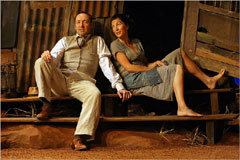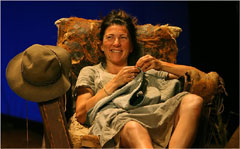|
The
New York Times, April 10, 2007
A Moonlit Night on the Farm,
Graveyard Ready
By BEN BRANTLEY
The woman who knows him best describes Jim
Tyrone as a “dead man walking slow behind his own coffin.” But that’s
sure not the impression given by Kevin Spacey’s beat-the-clock
performance in Eugene O’Neill’s “Moon for the Misbegotten,” which opened
last night at the Brooks Atkinson Theater.
Playing a graveyard-bound alcoholic in
this off-kilter revival, a production of the Old Vic Theater Company
from London, Mr. Spacey is as lively as a frog on a hot plate. When
his Tyrone rails against the universe, it is with the frenzy of a
fractious 2-year-old who has been told to eat his spinach. And he
rattles off the play’s big confessional soliloquies as if they were
the final verses of Gilbert and Sullivan patter songs.
What makes this Tyrone run — and I mean
run? Is Mr. Spacey trying to evoke a man desperate to outrace his
demons? Or is it just a matter of an artistic director, a role Mr.
Spacey fills at the Old Vic, determined to hustle a famously
long-winded show to the final curtain in less than three hours?
Such questions drift through the mind
during this streamlined (two hours, 50 minutes — whew!) version of
O’Neill’s last completed drama, a resounding critical hit in London,
directed with an emphatically comic slant by Howard Davies.
Mercifully Mr. Spacey’s hyperkinetic doings do not block the view of
the actress playing his unlikely love interest, Eve Best, a
sweetheart of the London stage in a commanding Broadway debut.

Sara Krulwich/The New York Times |
It may be the marquee power of Mr.
Spacey, a two-time Oscar winner, that draws audiences to the Brooks
Atkinson. But it is Ms. Best’s centered turn as a strapping country
girl that will keep them from growing as antsy as her co-star.
During the past decade Ms. Best has
emerged as London’s all-purpose leading lady in roles that run from
mouse (“The Heiress”) to man-eater (“Hedda Gabler”). New Yorkers now
have the welcome opportunity to savor the care and intelligence with
which she constructs a character. The part of Josie, the rural
giantess (“so oversize that she is almost a freak,” O’Neill writes),
is not a natural one for the fine-boned Ms. Best, but she makes it
fit.

Sara Krulwich/The New York Times |
Whether her presence alone warrants
another trip to the run-down Connecticut tenant farm where Josie
lives with her crafty father (Colm Meaney), and where Tyrone finally
finds peace, is debatable. “A Moon for the Misbegotten” was last on
Broadway only seven years ago, in a production starring a brilliant
Gabriel Byrne as Tyrone, with Cherry Jones as Josie. Older theater
addicts cherish memories of the 1973 revival with Jason Robards and
Colleen Dewhurst, still regarded by many as definitive.
Both those versions emphasized the
pathos of “Moon,” written in 1943 and first produced on Broadway in
1957. Inspired by the unhappy final chapters in the life of
O’Neill’s ne’er-do-well older brother, James, the play is singular
within its author’s body of work for its forgiving spirit. The other
drama in which Jim Tyrone appears, “Long Day’s Journey Into Night,”
left him in limbo. “Moon” grants the same man absolution as he nears
the end of a self-destructive existence.
The flip side of the haunted face of
“Moon” is the mask of comedy, Irish yokel style. And it is this side
that is stressed by Mr. Davies, who brought an irresistible tension
several years ago to O’Neill’s unwieldy “Mourning Becomes Electra,”
in a dynamite version at the National Theater in London, starring
Ms. Best and Helen Mirren.
O’Neill was never, to put it kindly, a
light-fingered humorist. Nor could his sentimental touch ever be
called feathery. His greatness is in his despair. At times,
especially as Josie and her father swap insults and scheme to outfox
an arrogant patrician neighbor (played by Billy Carter), “Moon” can
feel like a prequel to “The Beverly Hillbillies,” an impression
confirmed by Bob Crowley’s Dogpatch set. And when Tyrone, the
Hogans’s landlord, shows up for a drink, he fits right into their
vaudevillian rhythms.
What the 2000 production, directed by
Daniel Sullivan, brought out so affectingly was the extent to which
the comic shenanigans are so much posturing — clownish roles assumed
to keep harsher truths at bay. A great “Moon” progresses into the
heart of the pain beneath the laughter.
Yet even in the play’s climactic scene,
in which Tyrone reveals his love for Josie and the cancerous
self-disgust that makes him drink, the audience keeps laughing. Mr.
Spacey brings a stand-up artist’s timing to Tyrone’s reversals of
mood so that they land like punch lines.
That Tyrone is a former small-time
actor may have been the cue for the artificiality with which Mr.
Spacey invests much of his dialogue. But I was always more conscious
of the actor Kevin Spacey than of the actor James Tyrone. Mr. Spacey
is a polished pro who can play himself like an organ. He dexterously
pulls out the stops for sincerity, contempt and the swelling anger
of an attention-starved, tantrum-prone child who never grew up.
But aside from a couple of searing
moments, as when a delirious Tyrone mistakes Josie for a whore,
these disparate notes never blend into the integrated music that
makes a character real. The I’m-talking-as-fast-as-I-can delivery,
which Mr. Spacey used to more persuasive effect in Mr. Davies’s fine
1999 production of “The Iceman Cometh,” mostly registers as shtick.
Mr. Spacey, by the way, was an
excellent Jim Tyrone in the 1986 Broadway revival of “Long Day’s
Journey,” a staging that — come to think of it — also had unusual
breakneck pacing. Here, he often seems to be paying homage to the
star of that production, Jack Lemmon, an actor who specialized in
comic distress and sentimental anguish. This is a mistake, since
even Mr. Lemmon wasn’t always convincing as Mr. Lemmon.
Mr. Meaney gives a solid, likable
performance as Hogan that resists Pappy Yokum cuteness. But the
night belongs to Ms. Best, who clearly and winningly maps the
contradictory levels of Josie Hogan, both the blustery facade and
the sensitive core. Her not matching O’Neill’s description of a big
bruiser only feeds our sense that Josie has created a persona to
hide behind, as Ms. Best clomps about the stage like a wrestler in
search of a match.
The toll of sustaining this facade
registers with touching specificity in the play’s penultimate scene,
when a weary Josie collapses like a marionette with its strings cut.
It has been hard shouldering all that pretense for so long. Of
course the realism of the moment is probably enhanced by Ms. Best’s
also having had to shoulder the entire emotional weight of a heavy
play. |

